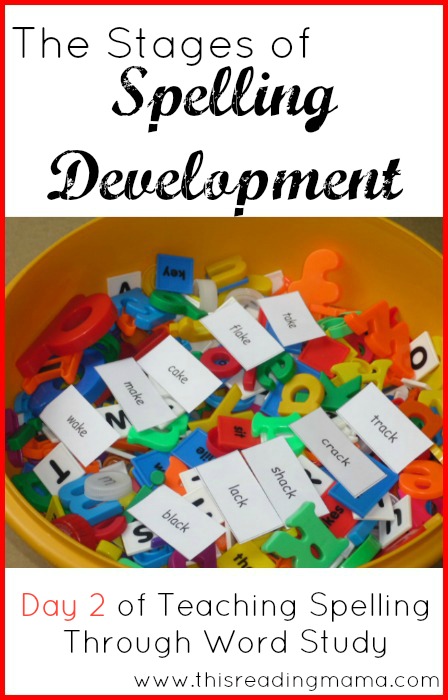 *This post contains affiliate links. Please read my full disclosure policy for more information.
*This post contains affiliate links. Please read my full disclosure policy for more information.
If you’re new, welcome to This Reading Mama! I’m joining 39 other bloggers with iHomeschool Network as we post for 10 days on various topics. I am exploring a series called Teaching Spelling Through Word Study. And if you’re just joining me, you’ve only missed one day. Yesterday, we explored the difference between traditional spelling and word study. {You can click here or on the image above to view that post.}
Understanding the Stages of Spelling Development
Understanding spelling development is key with word study because, unlike traditional spelling, word study seeks to teach students at their own level of development (also known as their instructional level). And how do we know a child’s level or stage of spelling development? As children progress through different spelling development stages, they naturally exhibit certain characteristics.
Today, I want to identify the spelling stages with examples from each; but I won’t leave you hanging there. In the next couple of days, we’re going to explore how to identify your child’s stage and what to do with this information.
Stage 1: Emergent Spelling Stage (Let’s Learn Our ABC’s)
At the beginning, they “spell” haphazardly with marks (such as scribbles) all over the paper. Their drawings and writing are indistinguishable.
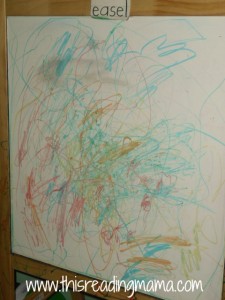 MBug (2 years old) is in the beginning stages of Emergent. While she knows her letters (not sounds, yet), this is how she “writes”. Sometimes, she’ll even “read” me her writing. So cute!
MBug (2 years old) is in the beginning stages of Emergent. While she knows her letters (not sounds, yet), this is how she “writes”. Sometimes, she’ll even “read” me her writing. So cute!
As these spellers progress, real letters and numbers may be used, but the speller does not understand that letters represent sounds in words, so house may be spelled A1XT. They prefer uppercase and do not put space in between words. And they begin to write from left to right.
Towards the end of this stage, spellers begin to match letters to sounds in words, so a word such as ball may be spelled with just the letter B, or G for alligator.
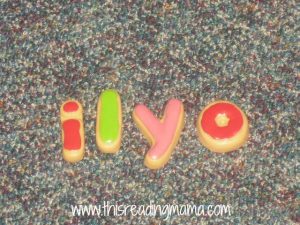 NJoy (just turned 4) is at the end of the Emergent stage, which can be seen with his spelling of “I love you”. To read more about this stage, you can click here.
NJoy (just turned 4) is at the end of the Emergent stage, which can be seen with his spelling of “I love you”. To read more about this stage, you can click here.
Stage 2: Letter Name-Alphabetic Spelling Stage (I know my ABC’s)
At the beginning of this stage, spellers match written letters to letter sounds more consistently, but very few vowels are used. For example, wall might be spelled WLand heart spelled HT. Space becomes more regular, but still lacking.
As they progress, sometimes vowels are added in the middle of words, so bell may be spelled BAL and boat may be BOT (long vowels are easiest to hear)
Towards the end, spellers begin to spell most short-vowel patterns (CVC) correctly as well as blends and digraphs. High frequency words are spelled correctly. Long vowel patterns aren’t in place yet (PLAT for plate)
Here is an example of ALuv in this stage: “I had a bulldozer that went in the sandbox.” To read more about this stage, click here.
Stage 3: Within Word Pattern Spelling Stage (Looking for Patterns)
In the beginning of this stage, spellers are comfortable spelling short vowel words, blends, and digraphs.
As they progress, they begin to spell r-influenced words correctly (words with ir, er, ur, and or) They also learn how to spell most one-syllable long vowel words correctly, but will sometimes confuse them (WATE for wait).
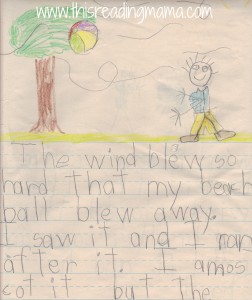 Here is one of ALuv’s (currently 7 years old) most recent journal samples. He is smack dab in the middle of this stage right now.
Here is one of ALuv’s (currently 7 years old) most recent journal samples. He is smack dab in the middle of this stage right now.
Towards the end, spellers can spell other kinds of vowel patterns (like the oi in toil or the ou in pound). As a matter of fact, spellers can spell most any regular one-syllable word (words like weight may still confuse them). To read more about this stage, click here.
Stage 4: The Syllables and Affixes Spelling Stage (Add on the Syllables)
- can spell most one-syllable short, long, and ambiguous words correctly; but now it’s time to take what they know and apply it to longer words
- confuse spellings where the syllables meet (such as when to double a letter before adding –ing or –ed)
- tend to misspell unaccented syllables, spelling INVUTATION for invitation or CONFUDINT for confident
- also misspell some prefixes and suffixes (such as PER- for pre– or –SION for –tion)
Stage 5: Derivational Relations Spelling Stage (Building Vocabulary)
- spell most common words correctly, but can confuse patterns such as:
- unaccented syllable spellings (schwa)
- silent consonants (EMFASIZE for emphasize)
- some suffixes and prefixes (MISPELL for misspell)
- “borrowed” word spellings
- To read more about stages 4-5, click here.
Can you, from the information above, identify your child’s level of spelling development…or at least make an educated guess? If you’re still not quite sure, over the next couple of days I hope to give you a few more tools for your word study toolbox. 🙂
More Spelling Development Resources:
- My new ebook, Teaching Kids to Spell , is based on teaching in a developmentally appropriate way. In it, you’ll find ideas for identifying your child’s spelling development stage as well as strategies to teach in each stage. The appendix is also full of printables you can print off and use with your child as you teach him to spell!
- 10 Days of Teaching Spelling Through Word Study {You’ve just read day 2 of this series.}
- Words Their Way: Word Study for Phonics, Vocabulary and Spelling Instruction
- Using Words Their Way to Teach Spelling
- Stages of Spelling Development
~Becky
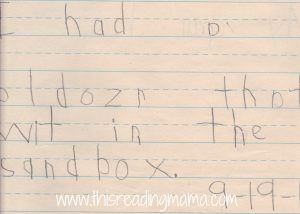
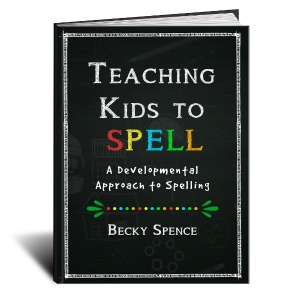
Excellent post! Your website is always such a great resource!!!
Thank you, Sarah. Your kind words are so needed today. 🙂
What a fantastic post! You have so many great resources on this website. I’d love for you to consider linking some of your posts in our Kid Lit Blog Hop – it’s on NOW and we’d love to have you. 🙂
Thank you so much for your post. I came across this because of an assignment in college but I plan on using some of it with my own children as a way of understanding their progress. I can say with absolute certainty that my son is currently in Stage 1. I do however see him progressing because as you’ve stated, he is starting to write the occasional letter here and there. Again, I thank you for this resource.
You’re welcome! 🙂
HI Becky! How important are backward letters in scoring at the Emergent Stage? Thanks!